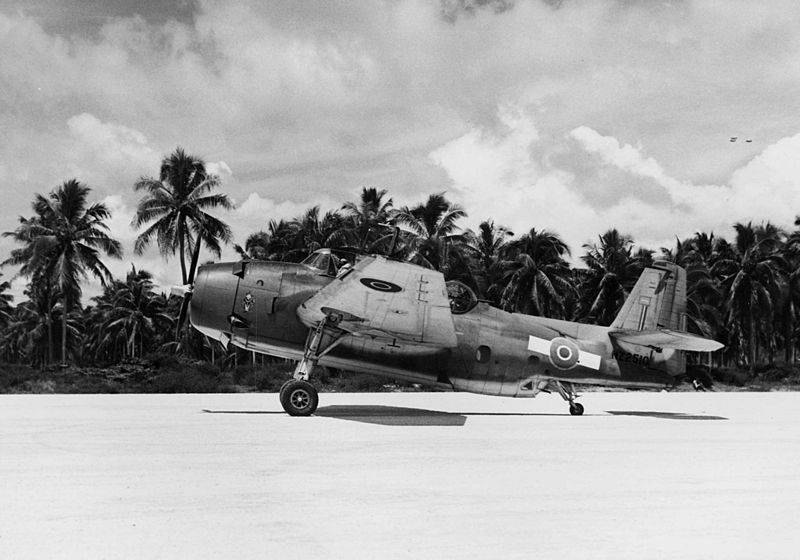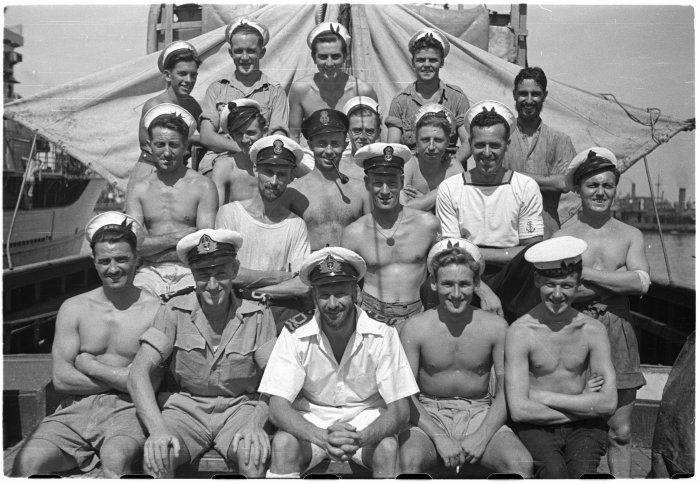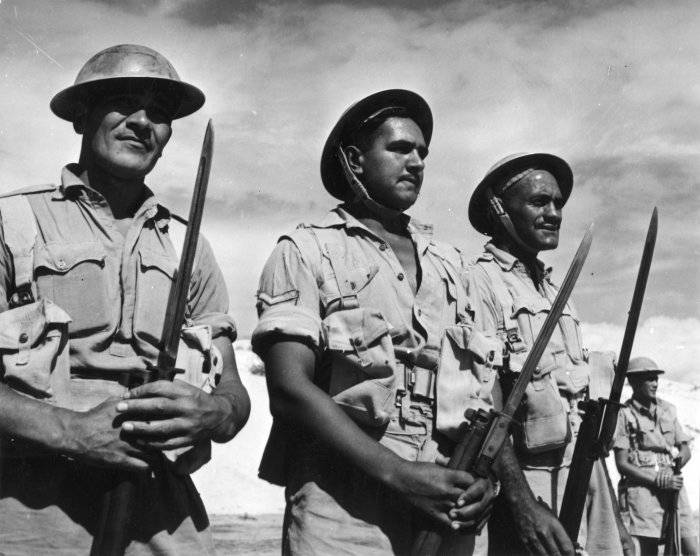New Zealand in World War II. Results and consequences
When the 3rd New Zealand Division was disbanded and its remnants transferred to Europe, only the New Zealand Air Force and Navy continued to participate in the hostilities against the defeated Japanese forces. The Royal Air Force of New Zealand actively participated in the destruction of Japanese contingents in the Solomon Islands, in Bougainville. Since November 1944, the 4th and 19th aviation squadrons, which were replaced by the 1945th and 8nd air squadrons in January 22, and by the 1945th and 9rd squadrons in March 23. Squadron rotation was fast enough. In May - July 1945, the 1st and 25th squadrons were located here; in July-August 1945, until the surrender of Japan, the 4th and 14th squadrons were located. New Zealand pilots demonstrated high combat skill, earning the respect of their colleagues from other states.

Despite the fact that the Japanese troops suffered an obvious defeat, they continued to resist fiercely, including air strikes. So, on January 15, 1945, the New Zealand 5 pilots were killed, and the sixth pilot was shot down and captured by Japanese prisoners, where he soon died from his wounds. Then New Zealand pilots participated in the battles for Okinawa, acting from the decks of four British aircraft carriers. Air battles were very fierce. Japanese aviation actively used kamikaze pilots, however, this extreme measure did not help against the skill of allied aviation pilots. The ships of the New Zealand Navy, including the corvette Erbatas and the cruiser Gambia, also participated in the battles for Okinawa. The last ship, by the way, became one of the most famous units of the Naval Forces of New Zealand. He was transferred to the Royal Navy of New Zealand from the metropolis - the UK, after which the crew of the cruiser 80% was staffed by New Zealand sailors and foremen, although the vast majority of ship officers were British. The cruiser took part in hostilities in the Indian Ocean, off the coast of the Malay Archipelago, and then participated in the famous Battle of Okinawa.
Due to the fact that the Air Force and Navy of New Zealand continued to participate in hostilities against Japan, the country rightfully became one of the winners of the “Empire of the Rising Sun”. 30 August 1945 New Zealand sailors landed in the port of Yokosuka and were met by representatives of Japan who had capitulated. September 2 The Gambia cruiser the New Zealand Navy moored in the port of Tokyo. On behalf of New Zealand, Vice-Marshal of Aviation Leonard Isitt signed the act of capitulation of the Japanese Empire. Thus ended the long epic of New Zealand’s participation in the war against Japan and in World War II as a whole. With good reason, the small Pacific state was among the winners of the “Axis countries”, having made a contribution from the point of view of other states and a very significant contribution to the victory over fascism for New Zealand itself. Of course, the loss figures of the New Zealand Armed Forces, compared to the losses of other allies, look, at first glance, very modest.

However, if we recall that the population of New Zealand itself was very small at that time, then we see a different picture. As a percentage of the death toll in the country's population, New Zealand surpassed all the allies in the anti-Hitler coalition. Recall that by the time the Second World War began, 1,7 million people lived in New Zealand. Thousands of men and 194 of thousands of women were mobilized to the regular armed forces of the country, i.e. 10 Thousands of People - 204% of the population. Of these, 12 New Zealanders died, i.e. New Zealand Army losses per million people were 11625 people. This is more than Australia and even Great Britain. The most serious losses, as noted by historians, have suffered the New Zealand air force. Pilots of the New Zealand Aviation were involved in battles in Europe, Africa, and the Pacific Ocean. New Zealand Aviation began to participate in the war much earlier than other types of armed forces of the country. In particular, the New Zealand pilots took part already in the air battles for Britain against the Hitlerite Luftwaffe.
The distant Pacific islands gave the British Empire a number of pilots - aces. Among them, in particular, we can mention the Wing Commander Henry Neville Ramsbottom - Isherwood (1905-1950), a native of Wellington, who began serving in the New Zealand territorial troops in 1924 year, and at the beginning of the 1930-s. moved to the UK, where he became a military pilot. It is this officer in this article that is worth mentioning because he commanded the aviation wing that supplied the British aircraft to Murmansk. In addition to the fact that British pilots delivered planes to Murmansk, they participated in the training of Soviet aviators. They had a chance to fight the Germans - from 12 September to 13 in October 1941, they made 365 sorties, accompanying Soviet bombers. For this, Henry Neville was awarded the highest Soviet award - the Order of Lenin. Unfortunately, the brave officer died after World War II, during the testing of the aircraft.
Were New Zealand positive for the victory in World War II, except for the fact that New Zealand troops defended their country against the approaching Japanese troops? First, New Zealand confirmed weapons and shed their right to participate in control of the Pacific Territories. The real status and possibilities of the British dominion have seriously increased. Moreover, the New Zealand soldiers fought not only in the Pacific, but also in Europe, North Africa, where they showed themselves very well. According to some researchers, the European and African theaters of war in terms of tension and concentration of resources for New Zealand turned out to be even more significant than the Pacific theater of war. That is, New Zealand was a loyal ally of Great Britain, who came to the aid at a difficult time and sent its soldiers to fight in Europe and Africa.
Along with Australia, New Zealand after World War II began to be regarded as one of the main guarantors of maintaining order and stability in Oceania. As a result of World War II, New Zealand retained control over the Cook Islands (transferred to New Zealand in 1901), Nauru Island (co-managed with Great Britain and Australia with 1923), Niue Island (controlled by New Zealand with 1901), West Samoa (administered by New Zealand from 1918). Tokelau (transferred under the control of New Zealand with 1925). As the real political independence of New Zealand increased after the end of the Second World War, the country's role in Oceania increased. In particular, New Zealand received more serious opportunities for managing trust territories, confirmed by the world community. This New Zealand influence on Oceania’s policy has persisted to this day. In particular, a huge number of students from the island states of Oceania study in New Zealand colleges, and New Zealand entrepreneurs invest in the development of the national economies of the Pacific states of Polynesia and Melanesia. The foundation for this was laid, including after the Allied victory in World War II.
The contribution of New Zealand to the victory over Japan was also appreciated. In particular, the New Zealand contingent was included in the Allied occupation forces, who were stationed in the “Empire of the Rising Sun”. Since immediately after the end of the war, very large-scale reductions of units and personnel were made in the New Zealand armed forces — a small country did not need to keep such a large army in peacetime, in Japan, most of the New Zealand soldiers and officers remained in the ranks. The Japanese brigade group under the command of brigadier Keith Stewart was concentrated on Japanese territory, including the 9 and 22 infantry battalions, the cavalry regiment, the 27 artillery battery, the 25 engineering company, and support units. Also in Japan 5-I aviation squadron was stationed. In total, 14 NZ soldiers and officers turned up in Japan. Only the 4320 Battalion of the New Zealand Royal Infantry Regiment remained at home, the rest of the armed forces were reduced.
Secondly, the tremendous tension with which New Zealand worked during the war years, supplying all kinds of resources and products for British needs, had a positive effect on the development of the New Zealand economy. The shock impact of the war on the New Zealand economy played a stimulating role. Moreover, during the war, the economy also had a mobilization character, the population was mobilized under compulsory execution of various works, and this use of the mobilized human resources also had a positive effect on the country. Thanks to participation in the war, New Zealand has seriously grown stronger, and not even so much in the military, as in the economic and political relations. From the distant dominion of the British Empire, it became practically an independent developed state, capable of pursuing a policy in its own interests.
Thirdly, the participation of New Zealand in World War II had a positive effect on the strengthening of interethnic relations in the state. As it is known, in New Zealand, as well as in neighboring Australia, the indigenous population remained. In New Zealand this is Maori belonging to the Polynesian peoples. History The relationship between Maori and the white settlers is full of dramatic pages, primarily related to the armed confrontation during the colonization of the islands. The decision to create a separate 28 battalion as part of the 2 New Zealand Division from Maori was very correct, since joint participation in the war turned yesterday's opponents into brothers in arms. The Maori were aware that New Zealand was their homeland, which had to be protected with weapons in their hands, and the whites were that Maori were their fellow citizens, who were also able to show courage and courage in the war for common interests and, in fact, were no different from them. Moreover, the presence of Maori in the ranks of the New Zealand Armed Forces seriously changed the order in the New Zealand Army. In particular, traditional Maori military rituals were borrowed, which were used in the New Zealand Army to increase the morale of soldiers. The hack dance today is danced by all the military personnel of the New Zealand Armed Forces, regardless of nationality, it has become one of the main symbols of both New Zealand and the New Zealand army.

It should be noted here that the Maori proved their worth during the war just fine. Their courage set an example for other New Zealand soldiers and officers. Thus, the Maori were the leaders in the number of military awards received among the rest of the army, aviation and fleet. It is worth noting that the New Zealand command treated the Maori service in the armed forces not only condescendingly, but very positively. In particular, the Māori were given the opportunity to quietly advance to officer posts and to confer officer ranks. In the New Zealand Armed Forces, Maori appeared - officers who served on a common basis and could be subordinated to them by white soldiers. In particular, several Maori officers rose to the rank of battalion commander. In addition to the Maori, the New Zealand Armed Forces also included representatives of other peoples of Polynesia, for example, Fijians and Tongans. That is, participation in World War II contributed to the interethnic integration of not only the peoples of New Zealand, but also the peoples of Oceania as a whole. Subsequently, it also played a major role in the further cultural, political and economic development of the Asia-Pacific region.
After the end of the Second World War, New Zealand felt one of the combat-ready states of the “Western” world. The second half of the twentieth century was marked by the active participation of the country in the Asia-Pacific politics, including in armed conflicts, which in the 1950 and 1970 years. unfolded in various parts of the Asia-Pacific region. The complicated military-political situation in Southeast and East Asia demanded that New Zealand, immediately after the war, reduce the size of its armed forces to a minimum, begin to revive its combat power.
New Zealand units took part in the fighting during the war of the British troops in Malaya - against the insurgents of the Communist Party of Malaya in 1949-1964. The fighting in Malaya, by virtue of their specificity, became an excellent school for New Zealand special forces. The soldiers and sailors of New Zealand took part in the Korean War on the side of the United States, then in the Vietnam War, in which the New Zealand units of the commandos also distinguished themselves. Thus, the Second World War became the starting point for the further use of the New Zealand armed forces in regional military-political conflicts.
Information